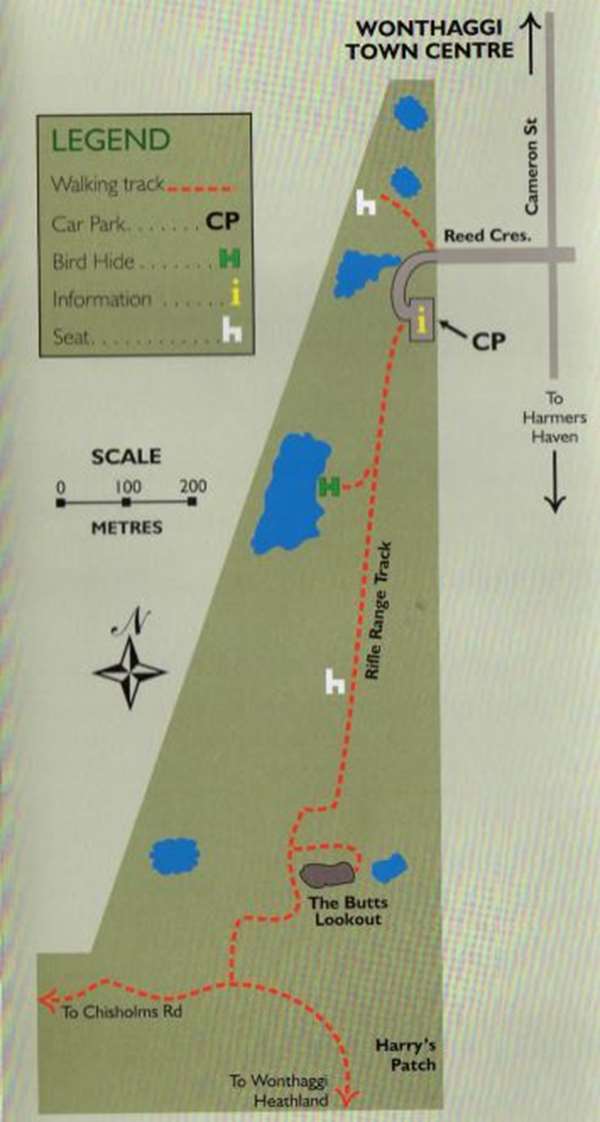Wonthaggi Rifle Range Wetland Reserve

Enjoy a scenic walk through the wetlands of the rehabilitated Wonthaggi Rifle Range before soaking in panoramic views from The Butts Lookout. Around 200m from the car park, the Wonthaggi Rifle Range Wetland track branches to the right to a bird hide overlooking the wetlands and if you're keen for a longer stroll, you can continue on from the Butts Lookout to the Wonthaggi Heathland and Coastal Reserve. A bit of fun trivia for you - The Butts is a mound of clay placed behind the targets of the old rifle range, with any bullets that missed the targets generally hitting the clay mound.

Brief History of the Reserve
- Once a vast paperbark swamp hunted over by the Bunurong tribe.
- 1846: Wild cattle run established by squatters. Cattle came from abandoned 1826 Corinella settlement.
- 1866: This cattle run was divided in two, the southern section known as the Powlett South Run.
- 1911: 500 acres/208ha set aside by Commonwealth Government for a rifle range.
- 1911 to 1997: Wonthaggi Rifle Club operated. Area cleared, fenced and grazed.
- 2005: Land passed from Commonwealth to Parks Victoria.
- September 2005: 23ha direct seeding using three methods: Rippa, Mouldboard and Burford.
- November 2006: Two wetlands were excavated.
- July 2007: The wetlands overflowed for the first time. Many community planting days were held.
The Butts Lookout
The Butts is a mound of clay placed behind the targets to catch the bullets as they are fired. Any bullets that miss the targets and The Butts fall in the drop zone. This large area behind The Butts was not safe to walk in whilst the target shooting was in progress. The drop zone, in effect, protected the heathland during the life of the rifle range. Warning flags were in place on shooting days.
Flora
The Rifle Range has been planted with indigenous seeds collected and propagated by volunteers. In 2005, some 40 kg of seed was direct seeded. Despite two dry seasons, the area was flourishing by 2007. Many shrubs had flowered, set seed and provided food for birds, insects and mammals. Monitoring has established that the strike rate is 20,000 plants per hectare.
Tree species include: Coast Manna Gum, Swamp Gum, Narrow-leaf Peppermint and Messmate. The understorey plants consist of wattles, paperbarks, teatrees, she-oaks, bursaria, daisy-bushes and goodenia. Monitoring has shown that many plants have been recruited (seed in the soil, animal, bird and wind-borne seed) that were not in the direct seed mix.
From July to December 2007, the wetlands were planted out at community planting days. Many small groups of volunteers worked on this project. Many plants have emerged from seeds long dormant in the soil despite 100 years of cattle grazing.
Small plant species include: pondweed, crassula, water ribbon, golden spray, tree violet, club-rush, woolly teatree, water-milfoil, spike-rush and centella.
Fauna
By the end of 2010, 105 bird species had been recorded on site, many nesting. Waterbirds seen include: Whiskered Tern, Sharp-tailed Sandpiper, Australasian Bittern, Red-kneed Dotterel and Latham's Snipe.
Raptors sighted include: Black-shouldered Kite, Swamp Harrier, Brown Goshawk, Brown Falcon, Nankeen Kestrel and Wedge-tailed Eagle.
Other common birds that frequent the area include: Laughing Kookaburra, Eastern Rosella, Masked Lapwing, Noisy Miner, Flame Robin, Magpie Lark, Grey Fantail, Willie Wagtail, Australian Magpie and Richard's Pipit.
Pond life, especially frogs, damsel flies, dragon flies and yabbies is thriving. Kangaroos, wallabies, echidnas, wombats, bush rats, blue-tongued lizards and copperhead snakes have been observed. As the vegetation grows, recruitment of fauna from the heathland adds to the biodiversity of the area.
Since development of the wetland, the number of bird species has increased from about 20 to over 100.
Walk Summary
- Length/Time - 2km return / 1hour walking return (to the Butts Lookout)
- Grading is Easy
- Track surface is grass and compacted gravel
- Car park (unsealed) located in Reed Crescent, Wonthaggi
- Not suitable wheelchairs
- Not pram friendly
- Bicycles not permitted
- Seats at bird hide
Access for Dogs:
Dogs permitted on lead.
Location
169 Reed Crescent, Wonthaggi 3995 View Map








